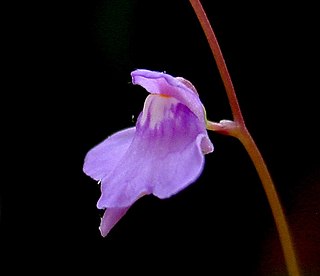
Utricularia amethystina, the Florida purple bladderwort, is a variable species of terrestrial bladderwort native to Bolivia, Brazil, Guyana, Peru, and south-west Florida. The small flowers can be purple, lilac, white, bluish, cream, or bright yellow, and are also highly variable in size and shape.
Utricularia quinquedentata is an annual, terrestrial carnivorous plant that belongs to the genus Utricularia. Its distribution ranges across northern Australia from Western Australia to northern Queensland and south to Brisbane. It was first identified by Ferdinand von Mueller as possibly a new species or variety in the early 1890s, noting it as "U. albiflora or a closely allied species." Mueller labeled one herbarium sheet as Utricularia albiflora var. quinquedentata. Without a valid description, according to the rules of botanical nomenclature, however, the epithet quinquedentata was not recognized until Peter Taylor validly published the species in 1986.
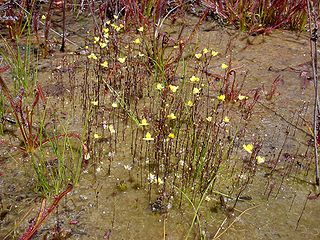
Utricularia subulata, the zigzag bladderwort, is a small annual, terrestrial carnivorous plant that belongs to the genus Utricularia. It is the most widely distributed species in the genus, being almost pantropical.

Utricularia biloba, the moth bladderwort, is a perennial, terrestrial or aquatic carnivorous plant that belongs to the genus Utricularia. It is endemic to Australia with a distribution along the coastal regions of New South Wales and Queensland.

Utricularia resupinata, popularly known as lavender bladderwort or northeastern bladderwort, is a small perennial subaquatic carnivorous plant that belongs to the genus Utricularia. It is native to eastern Canada, the United States, and Central America. This plant species has an interesting etymology, growth pattern, ecology, and research history. As a plant that is threatened or endangered in many of the States where it is found, it is a candidate for sound conservation efforts.

Utricularia aurea, the golden bladderwort, is a medium- to large-sized suspended aquatic carnivorous plant that belongs to the genus Utricularia. It is the most common and widespread suspended aquatic species in Asia. Its native distribution ranges from India to Japan and Australia.
Utricularia floridana, the Florida yellow bladderwort, is a large affixed aquatic carnivorous plant in the bladderwort genus within the bladderwort family). It is a perennial plant that is endemic to southeastern United States.

Utricularia inflata, commonly known as the swollen bladderwort, inflated bladderwort, or large floating bladderwort, is a large suspended aquatic carnivorous plant that belongs to the genus Utricularia. It is a perennial that is native to the southeastern coastal plains of the United States. It has often been confused with U. radiata, which is similar but smaller than U. inflata. Since 1980, U. inflata has been reported to exist in locations beyond its traditional range, such as the Adirondack Mountains in New York, southeastern Massachusetts, and in Washington State. Studies on the populations in the Adirondacks suggest that an introduction of U. inflata to a location where it naturalizes can lead to altered sediment chemistry by reducing the net primary productivity of native species. It is also listed by the state of Washington as a problematic species because of the dense mat-forming habit of this aquatic Utricularia. It is one of the few carnivorous plants that can be invasive.

Utricularia minor, the lesser bladderwort, is a small species of perennial carnivorous plant in the family Lentibulariaceae. It is usually found affixed to the substrate but it can also survive suspended in a body of water. U. minor is a circumboreal species and is found in North America, Asia, and Europe.

Utricularia intermedia, the flatleaf bladderwort or intermediate bladderwort is a small, perennial carnivorous plant that belongs to the genus Utricularia. It is usually found affixed to the substrate but it can also survive suspended in a body of water. U. intermedia is a circumboreal species and is found in North America, Asia, and Europe.
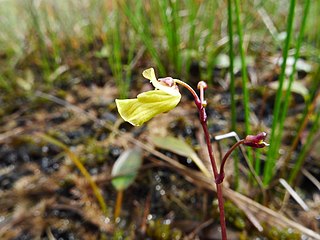
Utricularia ochroleuca, the yellowishwhite bladderwort, pale bladderwort, or cream-flowered bladderwort, is a small, perennial carnivorous plant that belongs to the genus Utricularia. It is usually found affixed to the substrate. U. ochroleuca is a circumboreal species and is found in North America, Asia, and Europe.

Utricularia olivacea, the piedmont bladderwort, is a very small, annual suspended aquatic carnivorous plant that belongs to the genus Utricularia. Utricularia olivacea is native to Central America, South America, the West Indies, and the eastern United States.

Utricularia radiata, the little floating bladderwort, is a medium-sized suspended aquatic carnivorous plant that belongs to the genus Utricularia. U. radiata is endemic to North America.
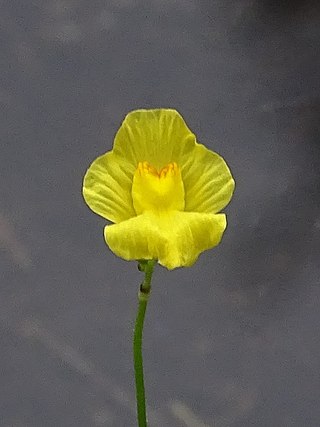
Utricularia striata, the striped bladderwort, is a medium-sized affixed subaquatic carnivorous plant that belongs to the genus Utricularia. U. striata is endemic to the eastern coastal plains of the United States.
Utricularia stygia, the arctic bladderwort or Northern bladderwort, is an affixed aquatic carnivorous plant that belongs to the genus Utricularia. U. stygia is native to northern Europe and North America. This species was originally published by Göran Thor in 1987 but the description was not in Latin and was therefore nomenclaturally invalid. Thor validly published the species a year later. The cited difference that separates U. stygia from U. ochroleuca is the shape of the tiny quadrifid glands inside the bladders, specifically at which angle the "arms" of these glands diverge from one another. Thor, when working on the Utricularia of Sweden noted that this distinction alone allowed for consistent species identification. Both Barry Rice and Peter Taylor have expressed concerns regarding how this method applies to other populations around the world.
Peter Geoffrey Taylor (1926–2011) was a British botanist who worked at Royal Botanic Gardens, Kew throughout his career in botany. Taylor was born in 1926 and joined the staff of the herbarium at Kew in 1948. He published his first new species, Utricularia pentadactyla, in 1954. In 1973, Taylor was appointed curator of the orchid division of the herbarium and, according to Kew, "under his direction, orchid taxonomy was revitalised and its horticultural contacts strengthened."
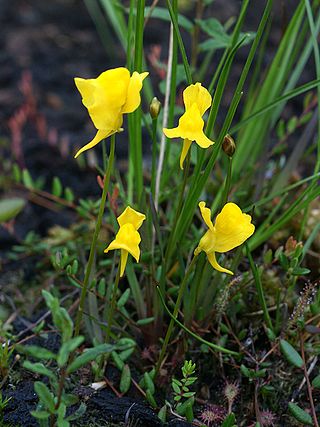
Utricularia cornuta, the horned bladderwort, is a small to medium-sized, probably perennial species of carnivorous plant in the family Lentibulariaceae. It is endemic to North America and can be found in the Bahamas, Cuba, Canada, and the United States. Utricularia cornuta grows as a terrestrial or subaquatic plant in marshes, swamps, and pools in shallow waters, mostly at lower altitudes. It was originally described and published by André Michaux in 1803.

Utricularia lateriflora, the small bladderwort, is a small to medium-sized perennial carnivorous plant that belongs to the genus Utricularia. U. lateriflora is endemic to Australia and can be found in New South Wales, Queensland, South Australia, Tasmania, and Victoria. It grows as a terrestrial plant in sandy or peaty soils in heathland at lower altitudes. It was originally described and published by Robert Brown in 1810.

Utricularia sandersonii, Sanderson's bladderwort, is a species of flowering plant in the bladderwort family. Originally described and published by the British botanist Daniel Oliver in 1865, it is a carnivorous evergreen perennial, endemic to northern KwaZulu-Natal and Transkei in South Africa.
Utricularia macrocheilos is a small annual carnivorous plant that belongs to the genus Utricularia. It is endemic to western tropical Africa, where it is only known from the mountain ranges of Guinea and Sierra Leone. U. macrocheilos grows as a terrestrial plant among wet rocks at medium altitudes. It flowers between August and January. A specimen of U. macrocheilos was originally included in the description of U. prehensilis by François Pellegrin in 1914 and also in John Hutchinson and Nicol Alexander Dalzell's 1931 description of U. micropetala. Peter Taylor recognized these specimens as a different taxon in a 1963 review of African species and treated it as a variety of U. micropetala. After further discussions with other botanists and review of the specimens, he elevated the variety to the species level in 1986 as U. macrocheilos. Compared to U. micropetala, U. macrocheilos has much longer corolla lips and less acute fruiting calyx lobe apices. Taylor notes, however, that the vegetative body of the plants and the seeds appear to be identical.















